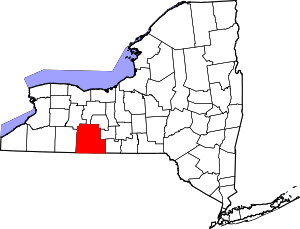Wayland, New York
Wayland is a town in Steuben County, New York, United States. The population was 4,314 at the 2000 census.
The Town of Wayland contains a village Wayland. The town is in the northern part of the county, northwest of Bath, New York.
History
The region was first settled by European Americans around 1806, after the Revolutionary War. In historic times, for centuries it had been territory inhabited by the Seneca Native Americans, one of the powerful five tribes of the Iroquois Confederacy.
The town was formed in 1848 from the Towns of Cohocton and Dansville. Part of Wayland was used to form the Town of Fremont in 1854.
The Rowe House is listed on the National Register of Historic Places.[1]
On August 30, 1943, the Lackawanna Limited wreck, occurred when the Lackawanna Limited, flagship passenger train of the Delaware, Lackawanna and Western Railroad sideswiped a local freight that had not cleared into a siding killing 29 people near the Gunlocke chair factory.[2]
Geography
According to the United States Census Bureau, the town has a total area of 39.5 square miles (102.4 km²), of which, 39.0 square miles (101.1 km²) of it is land and 0.5 square miles (1.3 km²) of it (1.31%) is water.
The north and part of the west town lines form the border of Livingston County.
New York State Route 21 is a north-south highway in the town and intersects New York State Route 15 and New York State Route 63 in the village of Wayland. Interstate 390 crosses the town from west to east.
Wayland is the western terminus of the B&H Rail Corp's Gang Mills–Wayland Line. Prior to 1956 it was linked to Rochester directly by rail. Prior to 1964 it was directly linked to Buffalo by rail. Both of these connections were removed by order of the U. S. Interstate Commerce Commission to promote highway transportation.
Demographics
| Historical population | |||
|---|---|---|---|
| Census | Pop. | %± | |
| 1850 | 2,067 | — | |
| 1860 | 2,809 | 35.9% | |
| 1870 | 2,553 | −9.1% | |
| 1880 | 2,591 | 1.5% | |
| 1890 | 2,334 | −9.9% | |
| 1900 | 2,984 | 27.8% | |
| 1910 | 2,836 | −5.0% | |
| 1920 | 3,004 | 5.9% | |
| 1930 | 3,071 | 2.2% | |
| 1940 | 3,078 | 0.2% | |
| 1950 | 3,178 | 3.2% | |
| 1960 | 3,385 | 6.5% | |
| 1970 | 3,546 | 4.8% | |
| 1980 | 3,881 | 9.4% | |
| 1990 | 4,311 | 11.1% | |
| 2000 | 4,314 | 0.1% | |
| 2010 | 4,102 | −4.9% | |
| Est. 2016 | 3,977 | [3] | −3.0% |
| U.S. Decennial Census[4] | |||
As of the census[5] of 2000, there were 4,314 people, 1,665 households, and 1,168 families residing in the town. The population density was 110.5 people per square mile (42.7/km²). There were 1,960 housing units at an average density of 50.2 per square mile (19.4/km²). The racial makeup of the town was 97.47% White, 0.86% Black or African American, 0.44% Native American, 0.42% Asian, 0.12% from other races, and 0.70% from two or more races. Hispanic or Latino of any race were 0.86% of the population.
There were 1,665 households out of which 35.6% had children under the age of 18 living with them, 52.3% were married couples living together, 12.5% had a female householder with no husband present, and 29.8% were non-families. 23.8% of all households were made up of individuals and 10.5% had someone living alone who was 65 years of age or older. The average household size was 2.56 and the average family size was 3.03.
In the town, the population was spread out with 27.9% under the age of 18, 6.9% from 18 to 24, 28.1% from 25 to 44, 23.7% from 45 to 64, and 13.4% who were 65 years of age or older. The median age was 38 years. For every 100 females, there were 96.6 males. For every 100 females age 18 and over, there were 94.0 males.
The median income for a household in the town was $42,575, and the median income for a family was $46,806. Males had a median income of $33,623 versus $22,439 for females. The per capita income for the town was $18,038. About 8.9% of families and 11.0% of the population were below the poverty line, including 15.8% of those under age 18 and 6.6% of those age 65 or over.
Communities and locations in the Town of Wayland
- Loon Lake – A lake in the south part of the town.
- Patchinsville – A hamlet south of Wayland village on NY-21 at the junction of County Road 90 (Patchinville-Perkinsville Road).
- Perkinsville – A hamlet southwest of Wayland village and north of Interstate I-390, by the junction of County Roads 90 (Patchinville-Perkinsville Road) and 91
- Wayland – The Village of Wayland in the north part of the town.
References
- "National Register Information System". National Register of Historic Places. National Park Service. March 13, 2009.
- "Testimony Conflicts at Wayland Train Crash Inquest". The Democrat and Chronicle. Rochester, New York. Sep 16, 1943. p. 33. Retrieved Nov 19, 2018 – via Newspapers.com.

- "Population and Housing Unit Estimates". Retrieved June 9, 2017.
- "Census of Population and Housing". Census.gov. Retrieved June 4, 2015.
- "U.S. Census website". United States Census Bureau. Retrieved 2008-01-31.
